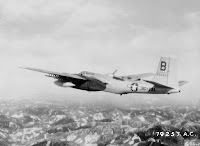I'm a veteran. I spent 10 years in the Air Force. Of course, Memorial Day is not a day to honor veterans. It's a day to honor those who gave their lives for the country. But, since I am an Air Force veteran, and since I like to share the stories of Medal of Honor winners on Memorial Day as a way of reminding us to be grateful for those who gave so much on our behalf, I'm going to focus on Air Force recipients on this Memorial Day.
I remember reading about Major Richard Bong when I was a kid. Now, technically, Major Bong was in the Army Air Corps, but I'm going to include him in this tribute. Dick Bong was the highest scoring American ace of World War II. He scored 40 kills while flying the P-38 Lightning. That may not sound like a lot. German pilot Erich Hartmann is credited with 352 kills, for instance. But the American military was in the habit of pulling aces out of combat when they reached a certain level of notoriety because of concerns for morale. As such, Major Bong was no longer in combat status after 32 victories. Instead, he was assigned as a gunnery instructor. Thus, his citation reads, "Though assigned to duty as gunnery instructor and neither required nor expected to perform combat duty, Maj. Bong voluntarily and at his own urgent request engaged in repeated combat missions, including unusually hazardous sorties over Balikpapan, Borneo, and in the Leyte area of the Philippines. His aggressiveness and daring resulted in his shooting down 8 enemy airplanes during this period." That's over and above. That's sacrifice. Major Bong died in 1945 test flying the new P-80 Shooting Star jet fighter. He gave his life for his country.
Meet Captain John Walmsley, Jr. John was a B-26 pilot in the Korean conflict. Part of his job was to develop tactics for using an 80 million candlepower searchlight installed on the aircraft for night attacks. On Sept. 12, 1951, he made his first successful night attack on a truck convoy. A couple nights later, he was back out searching for targets. He found a supply train and managed to disable it, but ran out of ammunition. So he called in a second B-26 to assist in finishing off the train. His technique? He turned on his light and gave the other pilot a clear view to make his attacks. Of course, that made Capt. Walmsley very visible. Despite the heavy flak from gunners all around the mountainous region, Walmsley refused to take evasive maneuvers so that the second B-26 could finish its attack. His plane was hit and he died that night in a fiery crash two miles away. Mission accomplished.
Since the Air Force only allows officers to fly, and most Air Force combat is flying combat, most Medal of Honor recipients in the Air Force would be officers. Staff Sgt. William Pitsenbarger is an exception. Flying almost 300 rescue missions in Vietnam, SSgt Pitsenbarger risked his life on a daily basis as he and the crew of the HH-43F helicopter they flew spent their days rescuing soldiers and airmen in trouble. On April 11, 1966, his helicopter was sent with another to extract a group of Army casualties pinned down in battle near Saigon. SSgt Pitsenbarger's job was to be lowered down on a cable, provide initial first aid to the wounded, then attach them and have them lifted back up. Of course, that was a dangerous job. After having rescued nine injured men, a helicopter that was lowering its litter basket took fire. They had to leave quickly, but Pitsenbarger didn't take the safe route and get in the litter. He waved them off and waited with the wounded. The enemy fire was too intense for a return flight, so he waited for an hour and a half while he improvised splints and stretchers for the injured. When the fighting troops ran low on ammo, he ran into enemy fire to retrieve ammo clips from dead soldiers to resupply them. Finally, he picked up a rifle and joined in the fray himself. SSgt Pitsenbarger was found the next day. He had been killed in the night by a sniper. In one hand he still held the rifle and in the other he still held the medical kit. He didn't survive, but nine men who wouldn't have without his efforts did.
These are just a very few of the stories of those who earned our nation's highest honor for our military personnel. Beyond these, there are vast numbers who died with less recognition. We owe our freedom to people like these who considered their sacrifice not too extreme in the service of their country. They deserve our gratitude and our respect.



2 comments:
I spent a good bit of my Monday reading a World War II Quarterly magazine that I had bought months earlier. One of the articles was on the Pearl Harbor attack, and another was on action in the Philippines over the next few days after Pearl Harbor.
I was quite the model builder as a kid. Remember Testors Paints, that came in colorful little glass cubes? I enjoyed best of all the 1/32 scale aircraft kits. I think the P-38 I put together had Dick Bong’s customized graphics on it, as decals. I also built a P-47, P-51, and an F4U Corsair.
Loved model building myself. I once gathered two planes from each major conflict, all of the same scale, and built them as realistically as I could. (The FW-190, for instance, had bullet holes and smoke, the B-17 had the access door replaced and oil from the engines on the wings, etc.) Lots of fun.
Post a Comment